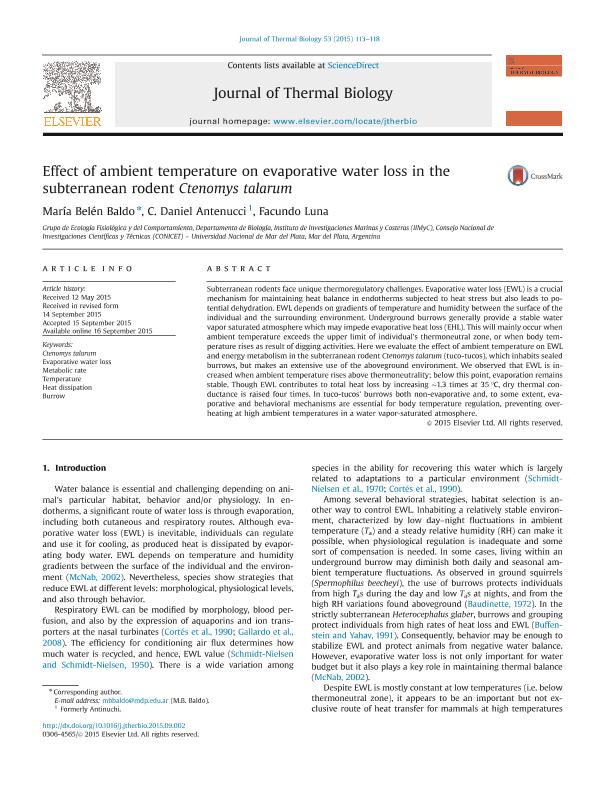Mostrar el registro sencillo del ítem
dc.contributor.author
Baldo, María Belén
dc.contributor.author
Antenucci, C. Daniel
dc.contributor.author
Luna, Facundo

dc.date.available
2018-06-27T16:49:23Z
dc.date.issued
2015-10
dc.identifier.citation
Baldo, María Belén; Antenucci, C. Daniel; Luna, Facundo; Effect of ambient temperature on evaporative water loss in the subterranean rodent Ctenomys talarum; Pergamon-Elsevier Science Ltd; Journal of Thermal Biology; 53; 10-2015; 113-118
dc.identifier.issn
0306-4565
dc.identifier.uri
http://hdl.handle.net/11336/50274
dc.description.abstract
Subterranean rodents face unique thermoregulatory challenges. Evaporative water loss (EWL) is a crucial mechanism for maintaining heat balance in endotherms subjected to heat stress but also leads to potential dehydration. EWL depends on gradients of temperature and humidity between the surface of the individual and the surrounding environment. Underground burrows generally provide a stable water vapor saturated atmosphere which may impede evaporative heat loss (EHL). This will mainly occur when ambient temperature exceeds the upper limit of individual's thermoneutral zone, or when body temperature rises as result of digging activities. Here we evaluate the effect of ambient temperature on EWL and energy metabolism in the subterranean rodent Ctenomys talarum (tuco-tucos), which inhabits sealed burrows, but makes an extensive use of the aboveground environment. We observed that EWL is increased when ambient temperature rises above thermoneutrality; below this point, evaporation remains stable. Though EWL contributes to total heat loss by increasing ~1.3 times at 35 °C, dry thermal conductance is raised four times. In tuco-tucos' burrows both non-evaporative and, to some extent, evaporative and behavioral mechanisms are essential for body temperature regulation, preventing overheating at high ambient temperatures in a water vapor-saturated atmosphere.
dc.format
application/pdf
dc.language.iso
eng
dc.publisher
Pergamon-Elsevier Science Ltd

dc.rights
info:eu-repo/semantics/openAccess
dc.rights.uri
https://creativecommons.org/licenses/by-nc-sa/2.5/ar/
dc.subject
Burrow
dc.subject
Ctenomys Talarum
dc.subject
Evaporative Water Loss
dc.subject
Heat Dissipation
dc.subject
Metabolic Rate
dc.subject
Temperature
dc.subject.classification
Otras Ciencias Biológicas

dc.subject.classification
Ciencias Biológicas

dc.subject.classification
CIENCIAS NATURALES Y EXACTAS

dc.title
Effect of ambient temperature on evaporative water loss in the subterranean rodent Ctenomys talarum
dc.type
info:eu-repo/semantics/article
dc.type
info:ar-repo/semantics/artículo
dc.type
info:eu-repo/semantics/publishedVersion
dc.date.updated
2018-06-26T13:34:38Z
dc.journal.volume
53
dc.journal.pagination
113-118
dc.journal.pais
Estados Unidos

dc.description.fil
Fil: Baldo, María Belén. Consejo Nacional de Investigaciones Científicas y Técnicas. Centro Científico Tecnológico Conicet - Mar del Plata. Instituto de Investigaciones Marinas y Costeras. Universidad Nacional de Mar del Plata. Facultad de Ciencia Exactas y Naturales. Instituto de Investigaciones Marinas y Costeras; Argentina
dc.description.fil
Fil: Antenucci, C. Daniel. Consejo Nacional de Investigaciones Científicas y Técnicas. Centro Científico Tecnológico Conicet - Mar del Plata. Instituto de Investigaciones Marinas y Costeras. Universidad Nacional de Mar del Plata. Facultad de Ciencia Exactas y Naturales. Instituto de Investigaciones Marinas y Costeras; Argentina
dc.description.fil
Fil: Luna, Facundo. Consejo Nacional de Investigaciones Científicas y Técnicas. Centro Científico Tecnológico Conicet - Mar del Plata. Instituto de Investigaciones Marinas y Costeras. Universidad Nacional de Mar del Plata. Facultad de Ciencia Exactas y Naturales. Instituto de Investigaciones Marinas y Costeras; Argentina
dc.journal.title
Journal of Thermal Biology

dc.relation.alternativeid
info:eu-repo/semantics/altIdentifier/doi/http://dx.doi.org/10.1016/j.jtherbio.2015.09.002
dc.relation.alternativeid
info:eu-repo/semantics/altIdentifier/url/https://www.sciencedirect.com/science/article/pii/S0306456515301212
Archivos asociados
